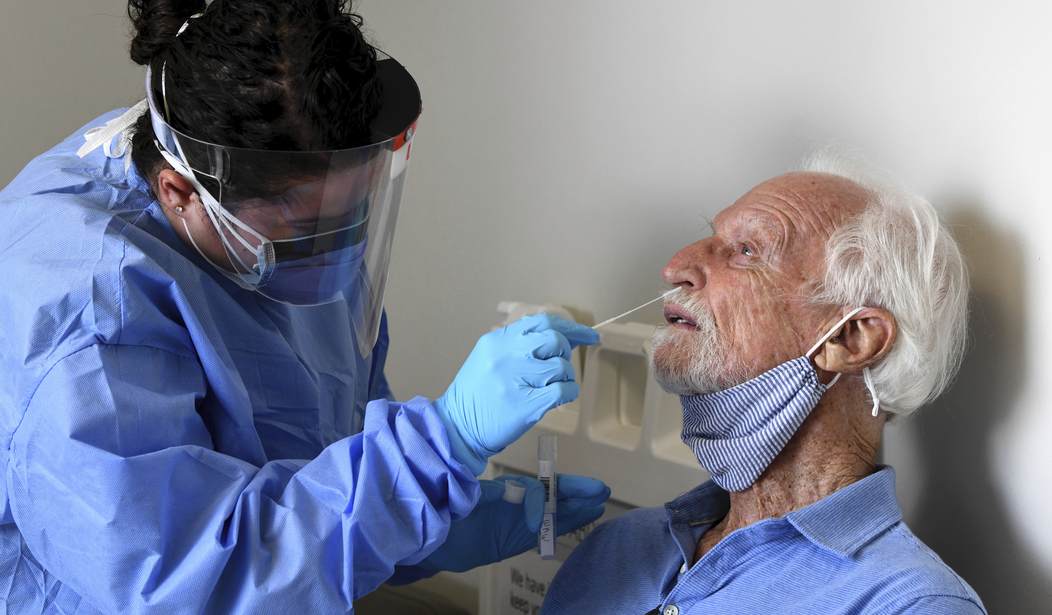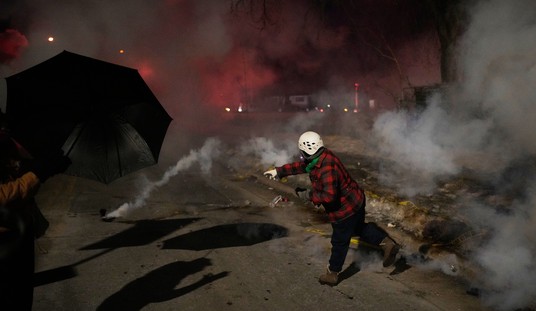I owe Matt Walsh at the Daily Wire an ass-kicking. Or at the very least, a slap across the face with a gauntlet and an invitation to step outside at dawn with a brace of dueling pistols. He makes more money than I do, so he can cover the cost of the firearms. I’ll spring for a couple of Grand Slam Breakfasts at Denny’s beforehand. At least three times now, I have heard him disparage nurses who have posted silly dance videos on TikTok, or have spoken about their COVID experiences. Now, Matt is known for his deadpan sarcasm, and I sincerely hope that is the case since A) I think TikTok contributes to brain rot B) I am not a violent man by nature, not to mention I am a horrible shot and C) I prefer Eggs Benedict for breakfast.
But whether or not Matt’s comments were in jest or earnest, I take issue with them. My wife is an ICU nurse who treats COVID-19 patients every day. I built a decontamination station in our garage so she did not have to worry about bringing the virus into our home. I have seen her exhausted with a thousand-yard stare after hours of donning and doffing PPE just to enter a patient’s room. I have seen the emotional devastation this disease has taken on her, not knowing if she has contracted the virus, or more appropriately, when she will contract it. And I have seen her tears after a day of helping patients and their families cope with what, in many cases, is an inevitable death sentence. And no one should ever have to utter the words “I am so tired of all the death.”
With that in mind, it is no wonder that nurses, in a few minutes of downtime, want to turn the pressure valve a little and shake their scrubs on TikTok. If that was your life, you’d need something to help you deal with a grim reality that probably is not going anywhere any time soon.
But Matt’s opinion reflects the mounting frustration with the state of COVID-19. Yes, one may surmise that there are those who are taking full advantage of this situation whether it is in the form of government overreach, the chance to take the moral high ground, or the ability to appear well-informed by rattling off statistics and infection and mortality rates.
Somewhere between the incessant lockdowns—and lost jobs and lives and government officials flouting the very same safety measures they demand of their constituents—the people decrying the pandemic as a combination of government conspiracies, and the neighborhood Karen—wagging her finger and condemning you to hell because you wandered into a convenience store without your mask—lies the truth about COVID-19.
Although I went in search of that truth, I am not so vain as to try to convince you that you will find it here. But I think my findings have merit. I did not seek out government officials, the legacy media, or the latest press releases. I did not turn to the CDC, the WHO, or the loudest politician. Instead, I got in touch with actual, real-life COVID nurses and asked a simple question: What do you want people to know about COVID-19?
Here is what they told me.
One nurse commented that, normally, there are peaks and valleys in care. The pressure is on for a while, the census is up and the workload is greatly increased. Then the valley comes and there is an opportunity to rest, recharge, and ready oneself for the next onslaught. But in the case of COVID-19, there has been a peak and then a plateau. The end is not in sight. Another nurse added, “Right now, pressure is always high, census is always high, we never get a break. Even people who don’t work in critical care are being floated there.”
Nurses become tired from donning and doffing PPE throughout the day, which could mean forgetting about lunch or bathroom breaks for the duration of a shift. It is a process that can be physically and emotionally exhausting. What goes into COVID PPE? To enter a patient’s room once a nurse must put on:
- A hair bonnet
- N95 mask
- Goggles or face shield
- A plastic isolation gown
- Shoe coverings
The nurse may opt to wear a PAPR – which is a face mask and hood with a hose connecting to an air filter. Bear in mind that this is what they put on before they enter a room and must take off when they leave. A visit to a patient’s room can include checking on the patient’s condition, bathing him, turning him over if he has been intubated, helping him to the toilet, assessing his condition, administering meds, and cleaning the room, since housekeeping cannot enter a COVID-19 room. And since diarrhea is one of the symptoms of COVID, a nurse may have to go into a room five to eight times a day to clean a patient. All of this while wearing enough gear to make Darth Vader winded.
Fresh PPE is required every time a nurse enters a COVID room, and should a patient “code” or require immediate attention, no one can enter the room to help until they are wearing the proper protection. Imagine how frustrating this must be for someone trained to respond quickly to a crashing patient, when seconds can mean the difference between life and death.
When possible, nurses, administrators and doctors have worked hard to try to safely bring family to the bedsides of loved ones who were about to die. But in some cases that is not possible. Many nurses have held iPads up for families to say their final goodbyes and to watch a loved one die. But when that became logistically impossible because of the patient load, the iPads were mounted on selfie sticks. One nurse told me it’s a poor substitute for human interaction. Said another nurse: “We are often the patient’s only socialization. We are the only ones they see on a regular basis, and if they have a smart phone they may have some interaction with family, but usually, we are the only people they see and we try to spend as much time with them as we can.” But given the number of patients, there isn’t much time to spare.
One nurse noted: “What you are hearing about the lack of beds in ICU is true in many hospitals. People are in the ICU for other reasons and ICUs are overflowing and we do not have enough staff to take care of them. And we are tired.”
One nurse simply used the word “exhausting” when asked about the demands on her and her colleagues. This nurse noted that the sheer demand has resulted in staffing issues and that some nurses have been on overtime for weeks, often picking up extra shifts simply because the need for skilled healthcare workers has increased more than exponentially. “Exploded” may be a better word.
The information age has introduced a unique set of complications to this pandemic. While many ICUs are full, the nurses said that the reports of unequal care, people being turned away from hospitals, and hallways lined with COVID patients and other breathless dispatches have often been sensationalized or made up by the media (including social media), keyboard warriors, and by those seeking public favor or office.
Said one nurse: “It is sad when a disease becomes political. This disease should not be made a political show. We need love and grace for everyone involved with COVID, and that package includes so many other people who are suffering as a result of the pandemic.”
Nurses do not want to see people avoiding the care they need out of fear of COVID-19. As it was explained to me, people are developing serious health complications as a result of putting off hospital visits, including the loss of limbs from infections, and even losing their lives. These are what one nurse calls COVID casualties: problems arising from the presence of the disease, but not necessarily caused by the disease. Other COVID casualties include upticks in suicide attempts, some of which are successful, particularly among young people. COVID-19 has impacted labor and delivery, and drug and child abuse rates have skyrocketed. The entire industry has been shaken.
But what about masks? What about social distancing? And of course, the battle cry, “First they said one thing, then they said another!”
As noted above, yes, there are those who are seeking to game the pandemic. But as a nurse explained to me: “Those of us on the front lines know how difficult and tricky this disease can be. The protocols and treatments are constantly evolving. I was told that while we need to follow the science, that science is constantly changing and with it, the game plan.”
Some of you may be thinking, “Quit whining. You’re being paid for this. You know the risks.”
I brought that up. One nurse explained it this way: “In a job such as law enforcement or emergency response, the potential exists for a tragedy like a mass shooting or mass casualty event. But this never ends. This is not normal. It is guaranteed every day, all day and has been going on every day for a year.” Another said, “We are seeing emotional and physical burnout. We try to leave it at the door when we come home, and at the hospital we do the best we can. We don’t see nursing as a casual career.”
But the nurses I talked to indeed saw burnout ahead for some caregivers, early retirement for others, or simple attrition. Many healthcare workers need, or have sought, mental health treatments.
But there is also triumph. As it was explained to me, “This pandemic has brought us closer together. It is the grace of God that has given us the added measure to do more with less.” She concluded:
I’d also like to add that even though this has been a hard time for nurses, at the same time we have had a lot of wonderful rewards. Patients surviving and beating the odds, love and gratitude shown from families and the communities around us, increased unity among our own unit and hospital workers. There needs to be more positive put out in the media. Not just numbers, statistics and tragedies. We need to see the good and beauty that comes from hard times, too.
So, for Matt Walsh, and anyone who cares to listen, that is the story of COVID-19 from the people who live it, breathe it, and fight it every day.
But these nurses are also opposed to the apotheosis of themselves or their jobs. They don’t want to be called heroes. One concluded by telling me: “Calling someone a hero puts a lot of pressure on them. The word ‘hero’ is intimidating.”
Indeed, it is. But in truth, a hero doesn’t necessarily wield a sword, a six-shooter, or a lightsaber. Not all heroes wear capes. A hero is someone with guts and the resolve to do a job that the rest of the world simply will not, or cannot, do.










Join the conversation as a VIP Member